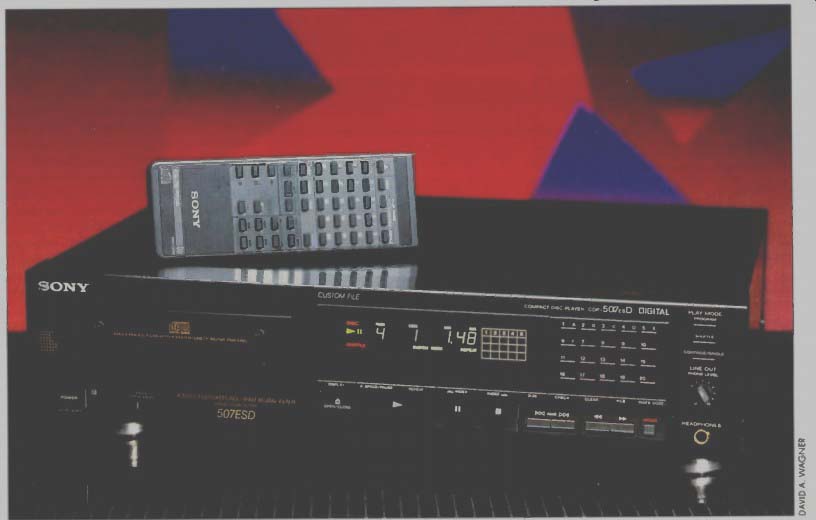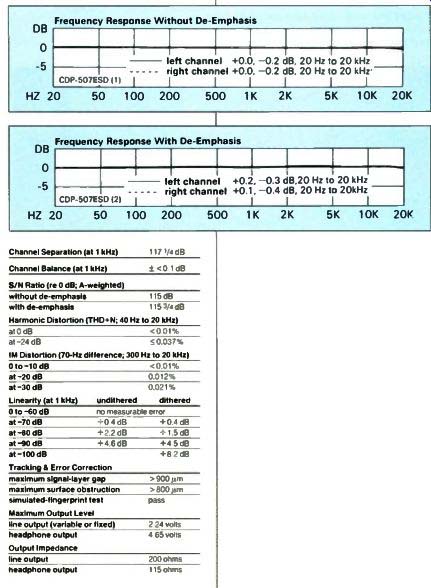Price: $600. Warranty: Limited, three years parts and labor, except one year on laser pickup and drive parts. Manufacturer: Sony Corp., Japan. U.S Distributor: Sony Corporation of America, Sony Dr., Park Ridge, N.J. 07656.
[Report preparation supervised by Michael Riggs, David Ranada, Christopher J. Esse, Robert Long, and Edward J. Foster. Laboratory data (unless otherwise indicated) is supplied by Diversified Science Laboratories.]
Sony has never been given to resting on its laurels (though goodness knows it has an enviable collection to rest on), and the CDP-507ESD continues the tradition of innovation.
It's not a question of breaking ground for some brave new CD world, but this model--which, not incidentally, is from the premium ES Series-exudes more individuality than most you are likely to peat selections); multimode repeat; automatic pause (an extra three seconds) at the end of each selection; single-selection play (which stops after the end of the current track); and Shuffle (random) play.
Both optical and pin-jack digital out puts are provided on the back panel. A switch nearby chooses between these and the two sets of analog outputs: one with a come across these days. And that stands out when designers, generally, seem pre occupied with covering whatever the competition is up to.
All the usual features are present: a dedicated wireless remote (powered by two AAA cells) that encompasses all of the standard transport features plus the various play-mode options; a headphone jack with its own level control; a timer switch; multiple elapsed/remaining time display modes; a "calendar" display of programmed or un-played bands; programmed play of as many as 20 selections (or 100 minutes of music, if you re fixed level and one whose level depends on the setting of the headphone-level control. This should supply all the flexibility anyone would want. (Some players let you use analog and digital outputs simultaneously, but any application I can think of that would profit from this capability is really pretty farfetched.) Before getting to the more arcane stuff--where the real fun is--a word of appreciation for Sony's manual. Though the one I have is merely a photocopy, and therefore renders as gray what evidently is in color, it obviously is of rare quality. The graphics are classy, if very low-key, and add materially to the exceptional clarity of both text and lay out-particularly the latter, which leads you directly from a two-page overview (plus one more for the remote) to the specific text that will explain a feature in more detail. I wish all companies took such care with--and, evidently, pride in-their work.
---------------
Dimensions: 17 by 4 1/4 inches (front), 13 inches deep plus clearance for connections.
Channel Separation (at 1 kHz)
Channel Balance (at 1 kHz) S/N Ratio (re 0 dB; A-weighted) without de-emphasis with de-emphasis 117 1/ 4dB 4 <0.1dB 115dB 11.5 df3 Harmonic Distortion (THD - N; 40 Hz to 20 kHz) at 0 dB 0 01 % al -24 03.037% IM Distortion (70-Hz difference; 300 Hz to 20 kHz) 0 to-10 dB at -20 dB 0.012% at -30 dB
Linearity (at 1 kHz) 0 to -60 dB at -70 dB at -90 dB at -90 dB +4 6dB at-100 dB
Tracking & Error Correction maximum signal-layer gap maximum surface obstruction simulated-fingerprint test
Maximum Output Level line output (variable or fixed) 2.24 volts headphone output 4 65 volts
Output Impedance line output headphone output 0.021 % un-dithered dithered no measurable error
All data were obtained using the Sony YEDS-7.CBS CD-1 and Philips 410-055-2 and 410 056--2 test discs
 --------
--------
Paradoxically, my one complaint about the player's overall design is with respect to functional clarity. The display includes index numbers, designed into the CD system as cueing marks within individual tracks but--unfortunately--seldom employed when CDs are cut. Sony also uses the word "index" for a different and most intriguing feature, adding further confusion to a subject that al ready is a source of distress to the classics lovers who could most have profited from disc indexing.
Sony's version, which it calls Custom Indexing, does to some extent pick up the ball that was so clumsily dropped by record producers. It lets you mark as many as six specific spots anywhere on a CD and begin play from any one of them. They are designated A through F, so they can't be confused either with track numbers or with the original indexing, if your disc has it. Like the track display calendar, that for the Custom Indexing disappears progressively as each cueing point is passed during play.
Among other unusual features, the player will remember your designation for the disc--up to ten characters long--and display it each time you insert the disc. By using the keypad as a sort of typewriter (albeit an awkward one), you can choose among all 26 letters, ten digits, ten miscellaneous symbols, and a blank space. You can also ask the player to store your programmed sequence in memory, for recall when you again play the same disc. These features aren't altogether unique, but they can contribute materially to your enjoyment of the player, depending on your habits and tastes.
Not only does the Custom Indexing system add an option for exploring (or--dare I say it, in this paranoid era?--dubbing) the musical minutiae of your discs, but you can also cue on the original index numbers, if your disc is so blessed. The index controls step forward and back just like the standard track-seek buttons: one number at a time. The dual-speed musical scan feature also helps find specific spots in the music and can be helpful in setting the Custom Indexing. One nice feature in the scan: When you run off the end of the disc, you don't land in the stop mode; instead, the display reads "OVER," and you can back the pickup into the end of the music-perhaps to savor just that final, cataclysmic chord.

And I expect you will savor it, be cause the performance-to quote from a note in Diversified Science Laboratories' report-"ranks up there with the best of them." Frequency response is very flat, distortion and noise very low, linearity very good. Even at the lowest levels that our dithered test disc now permits us to investigate, linearity remains better than average among the players we have had a chance to measure. Tracking is as perfect as the standard Philips disc will measure; it also looks good in trials with a Pierre Verany test disc, but we haven't yet compiled a large enough record for comparison on this basis.
How much of the CDP-507's obvious quality is attributable to its 18-bit, eight times resampling digital filter feeding a specially configured pair of 16-bit D/A (digital-to-analog) converters in each channel is hard to say. The oversampling digital filter undoubtedly contributes to the flatness of the audio band's top end in the final response, but when Sony claims behavior comparable to that of a "293rd order network," even the techno-philic mind boggles. Suffice it to say that high tech seldom hurts in such a context, and the tech here is among the highest.
Aside from my complaint about the indexing semantics-a cavil that, I hope, doesn't obscure how well the music accessing scheme works-I simply can find nothing to fault in this player. It is surprisingly easy to master, considering the complexity of its controls. It looks good and it sounds great. And the comprehensiveness of the controls is welcome. For instance, I really appreciate the single-track play mode for picking an individual selection out of a recital pro gram, and this feature is extremely rare despite its obviousness. Bravo, Sony!
- Robert Long
-------------
Also see:
Cambridge Audio CD-2 Compact Disc player (review, Oct. 1988)